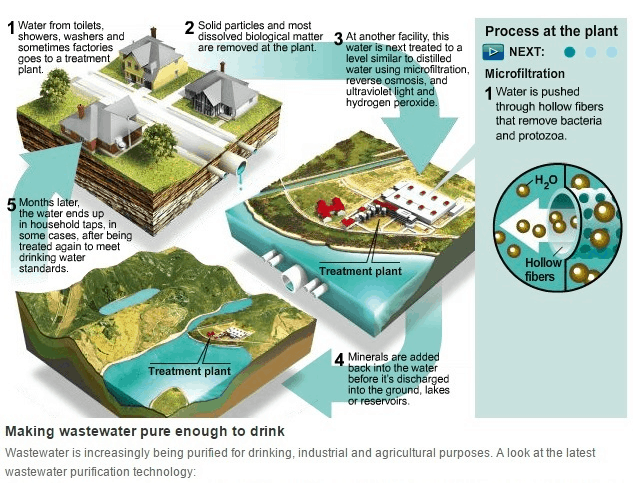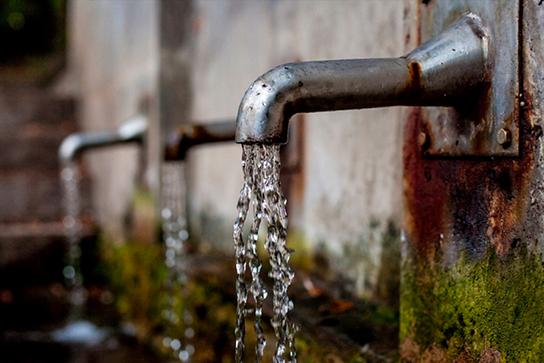Tap Water Source
Have you ever found yourself asking these questions;
- Where does our tap water come from?
- Is it safe to drink?
- How is it treated?
- Are there regulations?
If so, here you will find answers.
Water Cycle
Water constantly changes form; from mist or vapor, to liquid, to a solid state in ice form, in what is referred to as the water cycle. Precipitation, evaporation/transpiration, and runoff are the primary phases of this cycle.

Water is essential for life. It helps grow our food and serve as a lifeblood of our industries, but it can also be used to power electricity and, over half of our bodies are made up of it. Drinking water daily is a necessity in life, experts recommend drinking eight glasses of water a day, which is about half of a gallon. Not only you do you want to try and take in that much, but you also want to take in quality drinking water as well since some waters can carry bacteria, viruses, and other diseases if not treated properly.

Safe drinking water is a privilege Americans, as well as other countries, take for granted. To understand this, you need look no further than third world countries fighting for water drops on a daily basis, literally digging up dirt daily to find that small puddle of dirty water beneath it, in order to drink it to survive, hopefully parasite free. Polluted water is not guaranteed to be fully filtered this way because many chemicals and parasites do not fully breakdown in soil as it seeps down. Water treatment is necessary for safe drinking waters to avoid issues like the Flint Michigan’s water problem or even the bigger lead contaminated water plague that affected our schools and houses across the country in the late eighties, into the nineties. Before we get to types of treatment used to purify our water, let’s discuss where our water comes from.
Water Sources and Desalination
A community’s water source primarily depends on the foresight and planning of the founders and local use of the land and water sources in the area so every town, city, county, and/or state is going to have different scenarios on how they get their source primarily, but it is still going to come from the same type of source; surface water. Our surface water comes from lakes, rivers, streams, oceans, reservoirs, ponds, and other parts of the Earth’s surface, as well as groundwater wells and rain in general for those who harvest their own. The water goes from these sources to storage tanks, treatment plants, smaller reservoirs, and/or to houses directly through various piping systems.
The largest source is the ocean, but health concerns come with the saline water from the seawater and brackish, which are mostly found to be used in some western states like parts of California using seawater and parts of Texas using brackish water.

The seawater can be too salty for human consumption, or other purposes in general, and needs to undergo desalination procedures before so. Desalination has been a cost-prohibitive exercise due to the high amount of energy required to push the water through the compact micro-filters that remove the salt molecules. The largest desalination plant in this country, and possibly the world, is the Carlsbad plant which opened in late 2015, located in Carlsbad, California, costing roughly one-billion dollars to make. Carlsbad uses the reverse osmosis method of forcing the water through semipermeable membranes (which is a selective barrier, allowing some parts through while restricting others) under very high pressure. Improvements in membrane technology has produced filtration that lasts longer and are much more efficient than previous models.

Desalting brackish water is less costly because the levels are nowhere near that of seawater, brackish is more like the combination of lake and seawater. For example, the aftermath of a storm near an ocean would make normally pure lakes and ponds close by, to become brackish as it is mixed with salt water. Brackish water tends to go through a thermal process that heats the water enough to form a vapor, which is then condensed as freshwater leaving the salt behind.
Other Treatment
For standard surface water not requiring desalination, the main treatment goal is to remove water-borne diseases. Before disinfection became a common practice, widespread outbreaks of cholera and typhoid were frequent throughout the country. These diseases are still very common in less developed countries but have largely disappeared in the U.S. when chlorine and filtration became widely used nearly a century ago.
Common steps to treating water are coagulation and flocculation, where chemicals are added to the incoming water to bind with the dirt and dissolve particles, settling to the bottom as large particles, referred to as floc. The clear water then flows through filters composed of sand, gravel, and/or charcoal to remove the excess dissolved particles such as dust, parasites, bacteria, viruses and any remaining chemicals. Then chlorine or chloramine is added to kill any remaining parasites, bacteria, viruses, and germs. Ultraviolet lights and ozone can be used for disinfection as well, which some would say are cleaner and much more effective.

UV lights at certain wavelengths can become mutagenic to bacteria, meaning the light mutates the bacteria DNA, producing thymine that kills or disables the bad microorganisms. Ozone is bubbled into the water in large tanks, destroying the illness-causing microorganisms, as well as taste and odor. Fluoride is usually added to water as well, to prevent tooth decay.
Various other chemicals are added as well to adjust hardness and pH levels, or to prevent corrosion. Based on the water source and piping system, corrosion is a big contamination when considering that many old water pipes were made with lead. While the most effective solution may be to replace the lead pipes, that is not highly feasible in some areas, so water utilities add some form of phosphate to the water supply, which forms a protective film between the lead and water flowing through it.
When you look at the water crisis in Flint, Michigan, or Baltimore, Maryland, for examples, you can see that preventative measures were not taken. In Flint, the water source was changed from the City of Detroit water source to the Flint River, but no additives were put in place to prevent the corrosion of the pipes, which contributed to the high lead levels found in the water. When you find that Flint River has eight times the amount of corrosion as the City of Detroit’s source did, it’s not hard to see that Flint politicians and environmental reps failed to take initiative measures like adding orthophosphate to control the corrosion when the water sources were switched. Someone did not do their homework here, and others will pay for it as low levels of lead poisoning can cause behavioral problems, slow growth, and even affect IQ levels.

Lead is not the only thing contaminating our water sources either, in farming communities across the country, water can be contaminated by fertilizer and livestock as well. Nitrate runoff in rivers and groundwater can also be common in places with high levels of farming activities, which causes “blue-baby syndrome” where infants can suffer from shortness of breath, which if left untreated, obviously can lead to death. In Des Moines, Iowa, nitrate has shown up so much that the Water Works utility company has had to remove it through an ion exchange process in one of their treatment plants.

With the aforementioned waterborne diseases, it is critical for water sources to be disinfected before consumption so it is chlorinated from the time it leaves treatment center to when it arrives in our pipes.
Regulations
Some cities protect their water at the source too, with regulations and programs put in place. Instead of waiting for it to reach their treatment facilities, they use watersheds where those rivers, lakes, and ponds drain into. Supposedly, New York City’s watershed protection is so good, and the drinking quality is so high that their system needs no filtration at all. They have managed to keep it that way by regulating who controls the land around the sources, limiting the type of development that can occur and lead to pollution in the first place. Although the water is not filtered, it is still disinfected with chlorine and UV lights as well as the normal chemicals used to regulate pH, hardness and prevent corrosion.
While federal government has EPA to regulate over one-hundred-thousand water systems, local government also sets rules for these systems as well as over fifteen-million Americans that rely on private wells. From the source, to the tap, water goes through this critical process and is heavily monitored to prevent bacterial outbreaks, natural disasters, and human activity that could cause serious health concerns for the general public.
The driving force behind the development of drinking water standards and regulations is the protection of public health. Many laws have been adopted concerning water quality standards, going as far back as the Interstate Quarantine Act of 1893, which sought to control the introduction of communicable diseases from other countries. The first drinking water regulations prohibited the use of a common drinking cup on trains. The first federal drinking standard was adopted in 1914 but was limited to bacteriological quality, not physical and chemical requirements. Since then, more policies have been adopted and enforced to regulate the quality of drinking water for public use, such as the Safe Drinking Water Act (SDWA), passed by congress in 1974. This act gave the EPA authority to delegate implementation of drinking water regulations to states that have developed programs at least as stringent as the federal one.
Under the SDWA, public water systems are required to conduct testing on a regular basis. Weekly, monthly, quarterly, and annual studies are done on various spots. Private water systems like wells do not need to go by these tests, regulations or monitoring procedures, although they are recommended. Should a well be neglected and grossly contaminated, the government has in the past intercepted, closed down the well and fined the owners for neglect and polluting.
Systems today have methods of controlling nearly all properties of water; hardness, acidity, alkalinity, color, turbidity, taste, and odor, as well as the biological and organic chemical characteristics, so there is no reason to neglect.
Public agencies and private water developers have built thousands of reservoirs across the U.S. to capture seasonal runoff, protect against floods, and allocate water supplies throughout the years and these reservoirs store millions of acre-feet of water (think; flooding a football field). Areas that cannot harvest enough rain tend to get excess from areas that do, as mentioned at the beginning, it all comes down to how the founders and early settlers hashed it all out for the most part.

Reclaimed Water
Water recycling, or water reclamation, involves treating municipal wastewater to remove sediments and impurities for reuse. Right now, reclaimed water is used for park irrigation, some lakes, ponds, crops, etc. but greater technological advances and investments are returning so much impressive yields as they demonstrate how well it replenishes groundwater that at some point, it too will become so clean that you are drinking it. The toilet to tap concept is no longer an “if” statement, but a “when”.

Recap
Now, going back over the first set of questions;
- Where does our tap water come from? In short, Nature. Harvested by Earth and it’s habitats
- Is it safe to drink? Mostly, yes.
- How is it treated? Desalination, Filtration and/or Chlorination
- Are there regulations? Yes, heavy monitoring and frequent testing
Want to learn about other utilities?
Read about natural gas, its uses and how we harvest them here; Fuel Source
Learn the origins of electricity
